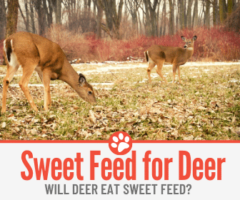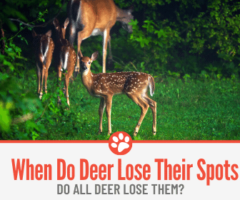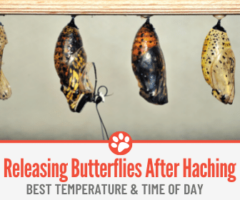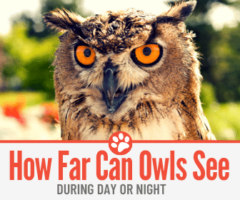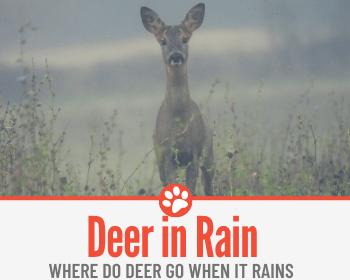 Lots of animals seek shelter when it rains, making it difficult to see or hunt them, so what about deer?
Lots of animals seek shelter when it rains, making it difficult to see or hunt them, so what about deer?
Where do they go when it rains and is this going to disrupt your chances of a good hunt?
In this article we will see how productive it will be to hunt deer in rain and where can you find the deer when it rains.
Where do Deer Go When it Rains?
Deer are not too bothered by light rain and winds and it does not always affect their movement patterns. However in heavy rain lots of deer will bed down and seek shelter in evergreen woods to protect themselves. Deer do not seem to like or dislike the rain and hunters have learnt how to use the bad weather to their advantage.
If there is only a light amount of rain or wind, deer don’t seem to be too bothered by the change and it will not effect their movement patterns by a lot.
Deer can sense oncoming storms and they are more active in the hours leading up to said storm. They forage for food before they bed down in deep woods under heavy rain, a lot of hunters see their best game in the hours leading up to a storm.
The simple answer to this question is that they don’t have one specific place they go when it rains. It all depends on the severity of the rain and their location. But lets have a look at how different species of deer deal with the rain below.
Where do Whitetail deer go when it rains?
Whitetail deer are medium-sized deer found from South America up to and across Canada, they get their name from the white underside of their tails. Game-management measures managed to bring these deer back up in population and they are now one of the most popular game animals.
These deer don’t appear to be bothered by rain at all unless its an unbearable storm. They will stay in more densely wooded areas when it is raining but their daily habits will not be altered.
Hunters have noted that in light rain, whitetail deer still follow their usual routes and appear in open fields to graze. There has also been reports that rain makes deer more docile as they feel less threatened in lower light, which is a common accompaniment to rain.
Where do Blacktail deer go when it rains?
Blacktail deer are found in the Pacific Northwest of Northern America, commonly occupying coastal woodlands. They are a sub-species of deer and got their name because of the prominent black stripe on top of their tail.
The coat of a blacktail deer changes through the seasons, being reddish-brown during the summer months whilst in winter their coat is brownish grey.
If you enjoy collecting antlers, they shed these annually between December and march.
Blacktail deer are not bothered by the rain and sometimes they become more active in the rain, possibly an evolutionary trait developed because hunters are more reluctant to go and hunt in the rain.
If the rain is torrential and accompanied by strong winds, they will often find sheltered areas to shield themselves from the downpour. They will find this shelter in densely packed forests along the coastlines.
Where do Mule Deer go when it rains?
Mule deer are a large species of deer native to western North America. This species encompasses a variety of subspecies, including the aforementioned Blacktail deer. These deer prefer more open landscapes and seem to feel less threatened by humans as they have somewhat integrated into city life.
Some populations of mule deer migrate over long distances, females leave first and males will then join in winter months for the rutting season.
When faced with heavy downpour most deer will seek shelter under forest canopies, but mule deer are found in places where these kinds of forests are scarce.
In heavy rain mule deer will seek any form of shelter they can find, often hiding under stray foliage where possible. That being said, Mule deer are used to light rain as they live in open country. This means that light rain won’t bother them and doesn’t affect their habits or movement.
Do deer like the rain?
So, whilst we’ve looked at how rain can affect the movements of deer, we still don’t know if they actually enjoy the rain.
Hunters that have cited increased deer activity in the rain and this has led to speculation as to whether deer simply prefer the rain.
This doesn’t appear to be the case as reasons for increased deer activity have evolutionary explanations. Heavy rain can altar a deer’s sense of smell and the noise of the rain can obscure the noise of threats such as predators.
To try and compensate for this hindrance, deer like to increase their field of vision to add a level of protection to themselves.
This is why deer are often found in open field areas when it is raining, so that they have a greater chance of spotting any predators or hunters looking for them. Because of the increased open activity it has led to the myth that deer like the rain when really it is for protection reasons.
What do deer do when it’s raining?
Deer activity often increases just before heavy downpours and storms are likely to occur, but what do they actually do when it starts raining? Once again this depends on the severity of the rain, but lets have a lot at how some of their common habits and routines may be altered.
Do deer come out in the rain?
As mentioned previously deer are sometimes spotted more frequently during the rain as they come out to open fields for protection. However, this does usually depend on the severity of the rain.
Deer have a slightly oily coat, which does help with protection from the weather, but it doesn’t provide much in the ways of thermoregulation. This means that deer do come out in the rain, but only in light rain with minimal wind.
Do deer bed down when it rains?
Deer can sense rain and storms, and prior to them they may often expend a lot of energy foraging for food before they bed down until the storm passes.
The heavier the rain, the heavier the shelter they will seek, that being said light rain will not usually cause them to alter their patterns and bed down. They are also more likely to bed down at night earlier, due to the shorter daylight hours that the rain causes.
Do deer move when it rains?
Not a lot affects moving patterns of deer but it does appear to be very clear that rain increases the amount of deer movement. The reason for this is because the rain provides cover for the noises deer make when they move, such as crunching leaves and snapping twigs.
Deer know that their movements are slightly obscured so are more likely to move around freely and with a less methodological approach than if it were a clear day.
Do deer come out when it’s raining at night?
There is no simple answer to this question as it usually depends on the severity and the length of the rain. If the rain is only light then a deer’s movements will not be altered and they will find shelter at night as usual.
However, if there is heavy downpour they will seek shelter until the rain lets up to a light drizzle.
This means that if the storm is due to die down at night, that may be the best time to go hunting as they will come out at night to forage as they could not during the day.
Where do deer go when it storms?
Storms can be quite dangerous for a deer, but they don’t have one set place they travel to during a storm.
Finding cover is the most important thing for a deer and since they can sense storms they may often use the time before the storm to search for the most densely covered areas to bed down.
They will also expend a lot of energy prior to the storm foraging before they bed down, some hunters say this is when they have had their most productive hunts.
They may move during the storms, but only when it lulls so if you are hunting during a storm, this is the best time to keep your eyes open.
Is deer hunting in the rain productive?
The thought of hunting in the cold and the rain is not a particularly appealing one. But seasoned hunters have had great success hunting during these weather conditions.
It is difficult to say that every hunt in the rain will be productive, as it won’t. It does depend on the severity of the rain and also the type of deer you are hunting. In very light rain, you are most likely to have successful hunts in open field areas as deer have learnt that the rain obscures the sound of their movements. T
hey also know that hunters are less likely to be out in the rain.
However, if you have a slightly heavier downfall, deer are most likely to be in sheltered forest areas. A medium rain fall won’t cause them to bed down but it will decrease their movement in open field spaces.
A torrential rainfall is not ideal as deer will often bed down during this weather. However, if you are willing to wait out the storm, hunters have said that as soon as the storm passes it is a very fruitful time.
This is because deer will use this opportunity to quickly move and forage, which they were not able to do during the storm.
Is it worth bow hunting deer in the rain?
Many hunters find hunting with bows to be very productive in the rain. The main issue for bowhunters is that rain can wash away the blood trail, to prevent this it is said you should limit your shots to the highest probability angles so they have less chance of moving a long distance.
You’ll have a better chance of hitting these high probability angles in the rain as well because deer are more likely to be out in open and less obscured areas. For more tips on how to successfully hunt in the rain, as well as gear yourself appropriately, have a look at this guide.
Related topics
What kind of weather do deer move in?
So, after looking at how rain impacts deer movement, lets look at other types of weather. The main two environmental aspects that affect deer movement are temperature and cloud cover.
Deer seem to move more when it is colder, possibly because they will expend more energy keeping warm, meaning they need to forage for longer hours.
Hunters find clear skies the best for hunting deer as clouds may signal a storm, meaning deer may be in denser shelter getting ready to bed down. Another aspect of weather that may affect deer movement is wind velocity.
Despite expectations, it seems that the harder and faster the wind blows, the more likely deer are to be spotted. Combining all of these, it seems that the most ideal day for hunting would be a cold day with clear skies and high wind velocity.
When is the best time to hunt deer?
This does depend on individual strategies but lots of hunters say they prefer hunting in the autumn months of September and October. Usually having the best hunts be in the early morning and evening.
Where do deer go when it snows?
Deer will avoid the snow where possible and move very little during these snowy months. They will go to yards for cover, a good example of this is a valley bottom with conifer cover.

